Abstract
Tandem-repetitive DNA hybridization probes based on a putative human recombination signal detect multiple polymorphic minisatellite fragments in human DNA. The genetic complexity of the resulting individual-specific DNA "fingerprints" was investigated by studying a large sibship affected by neurofibromatosis and a more extensive pedigree segregating for two different hemoglobinopathies. The segregation of up to 41 different heterozygous DNA fragments from each parent could be analyzed in a single sibship, using two different repeat probes. Most of these variable DNA fragments could not be paired as alleles, to an extent which suggests that the DNA fingerprints are together derived from approximately 60 heterozygous loci (approximately 120 variable fragments), only a proportion of which can be scored in a given individual. Two or three of the DNA fragments detected by one probe showed tight linkage and may be derived from long minisatellite(s) that are cleaved to produce more than one polymorphic DNA fragment. Excluding allelic and linked DNA fragments, almost all remaining scorable fragments segregated independently, allowing up to 34 unlinked loci to be examined simultaneously. These loci are scattered over most or all of the human autosomes. Minisatellite probes are therefore suitable for rapid marker generation and can be applied to linkage analysis in human pedigrees.
Full text
PDF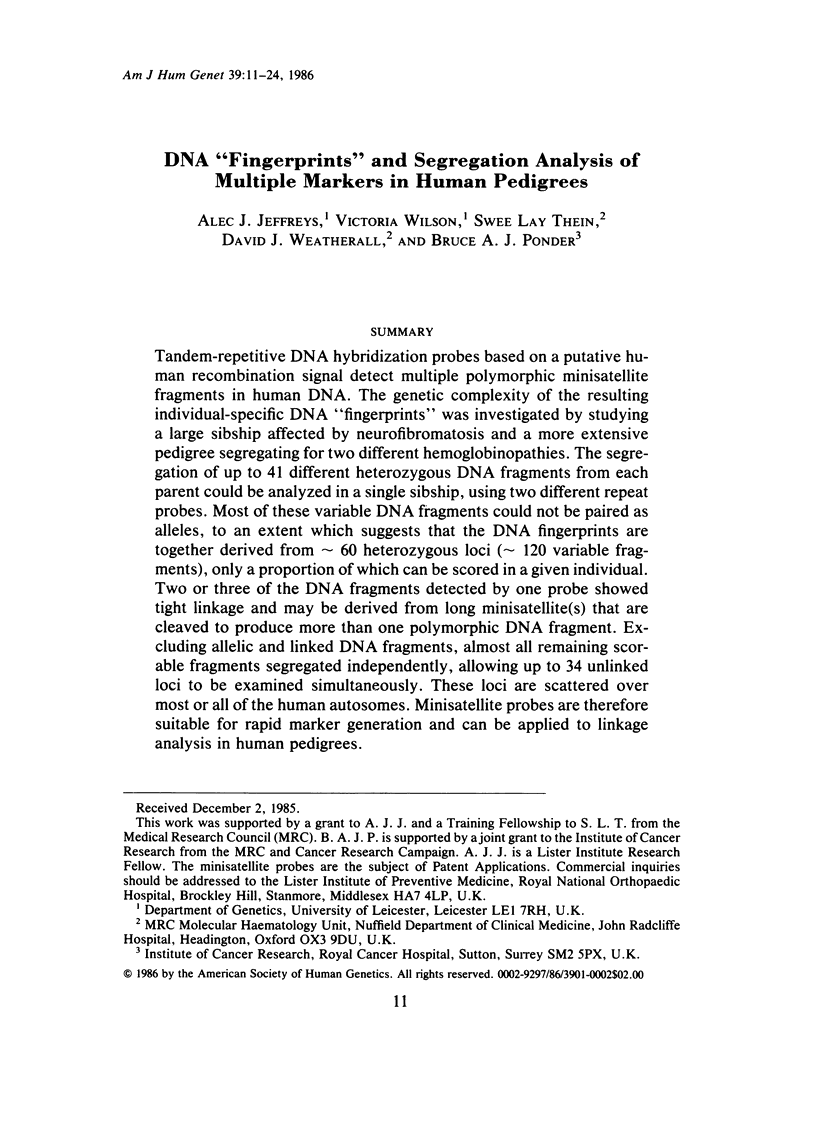
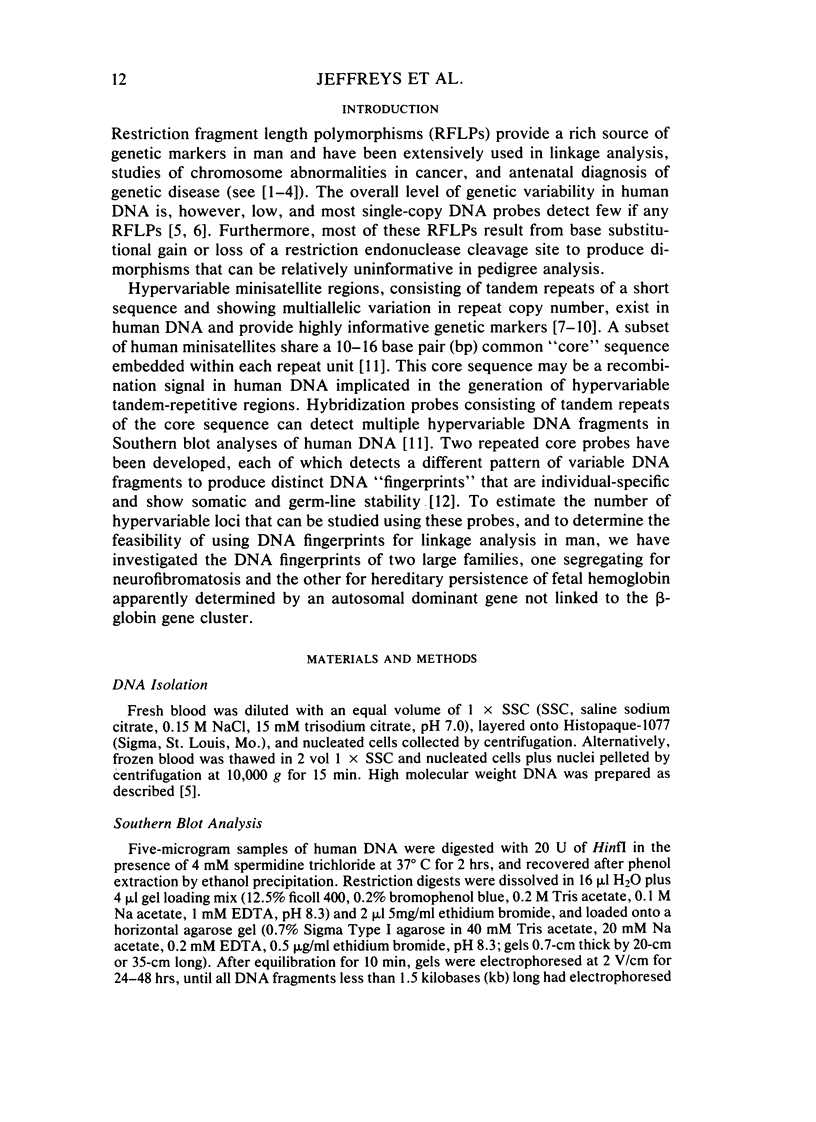
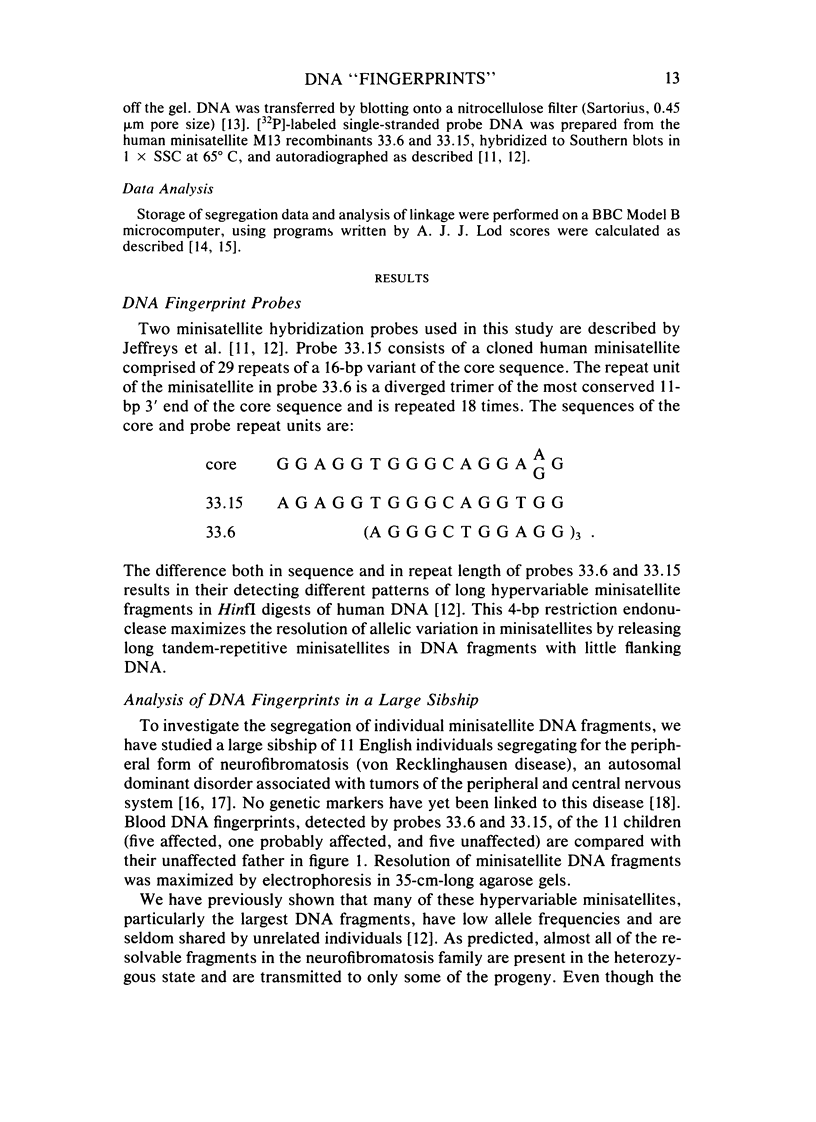
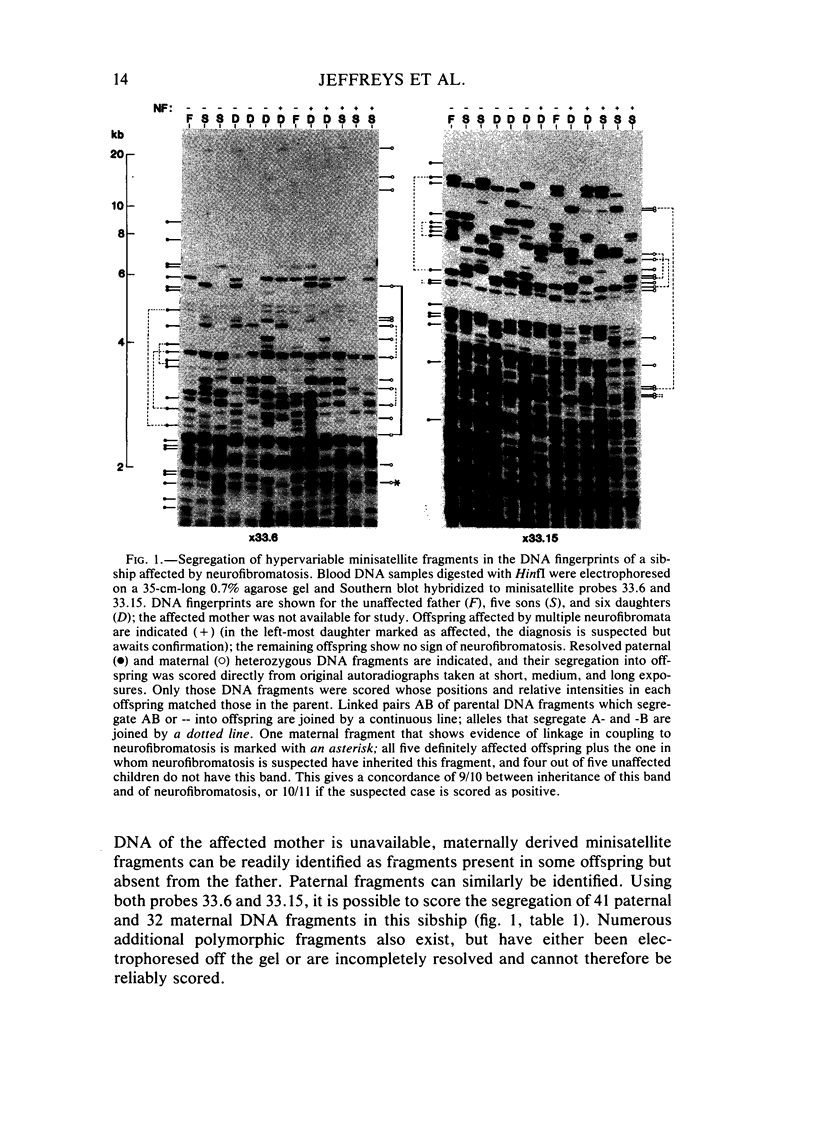
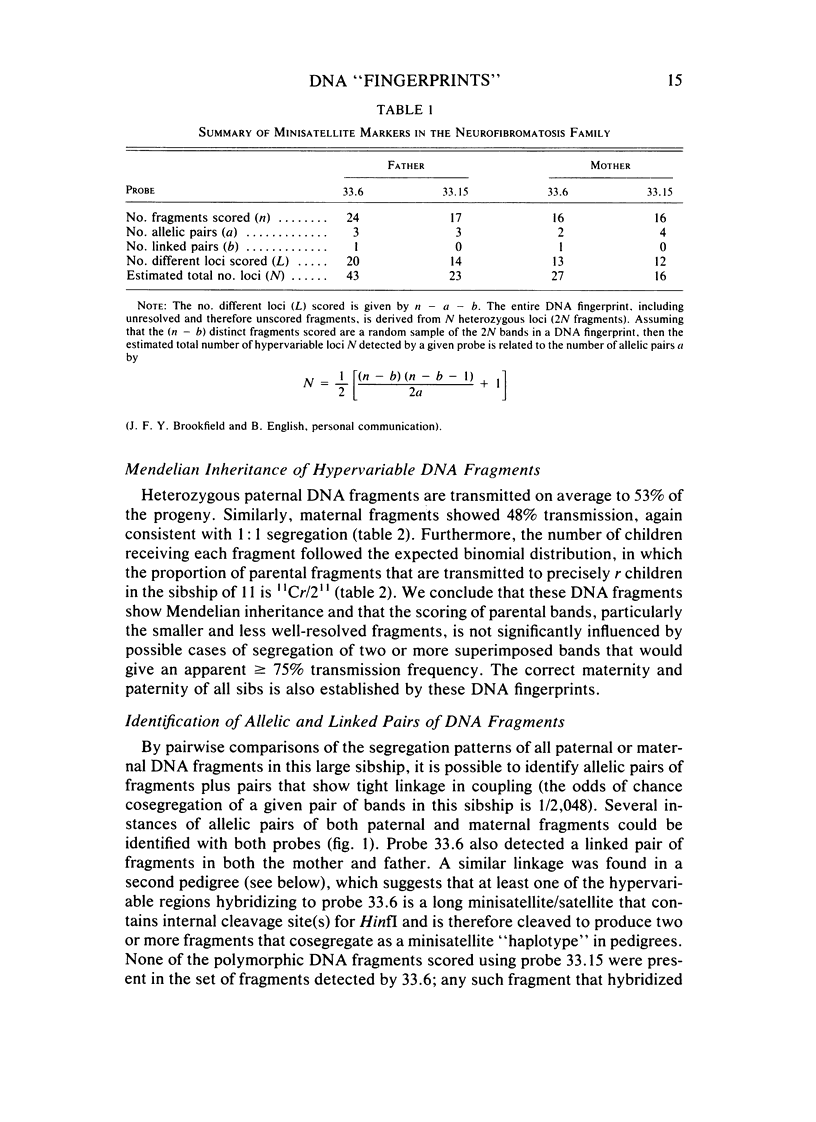
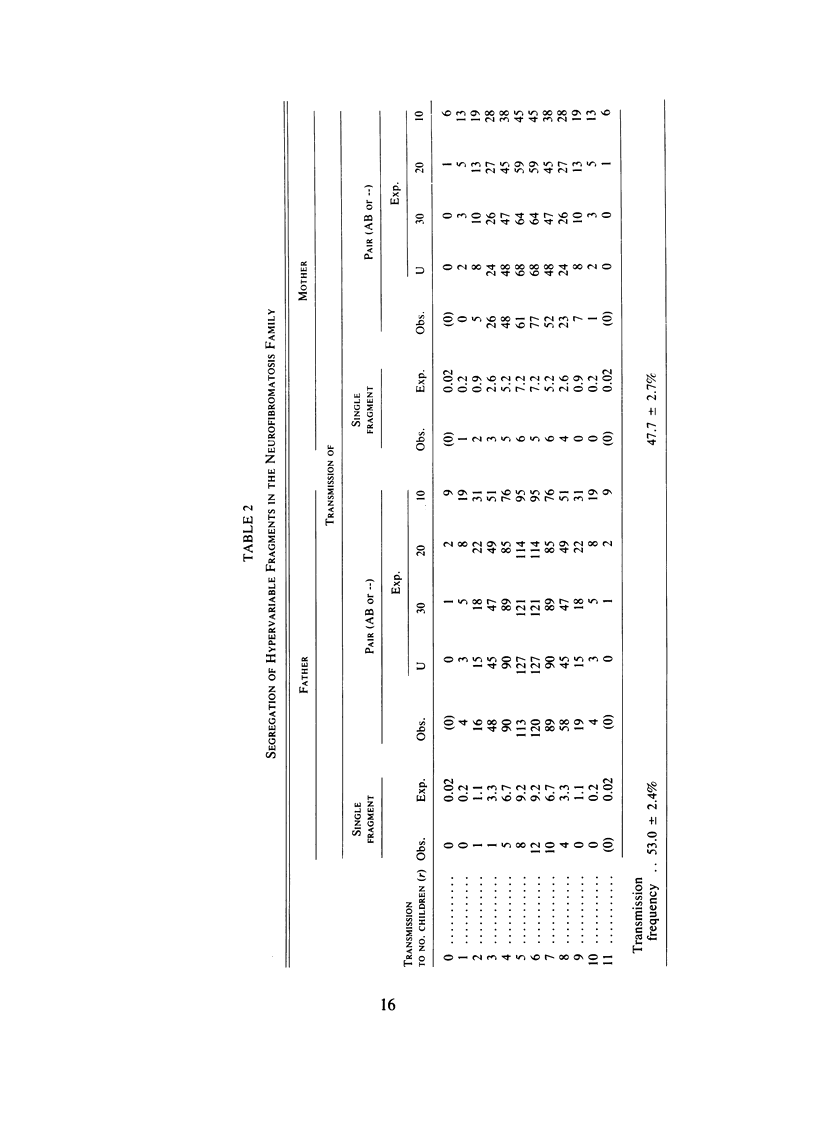
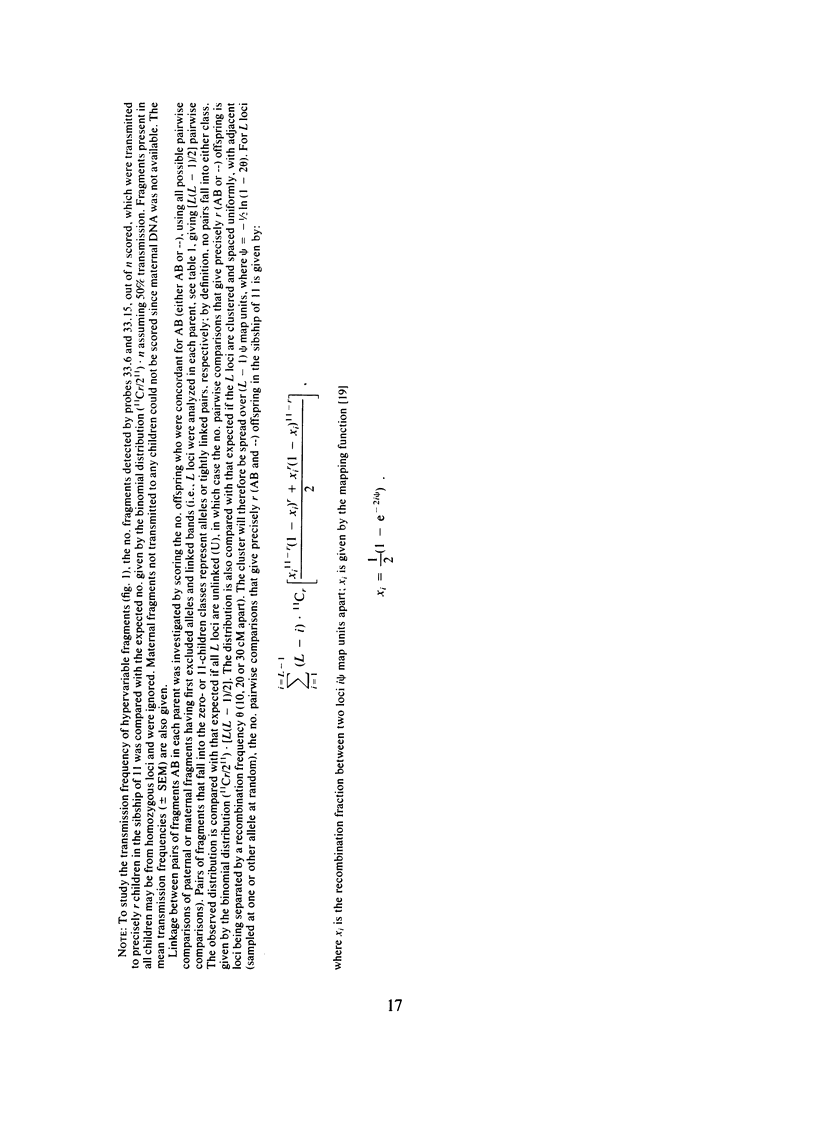
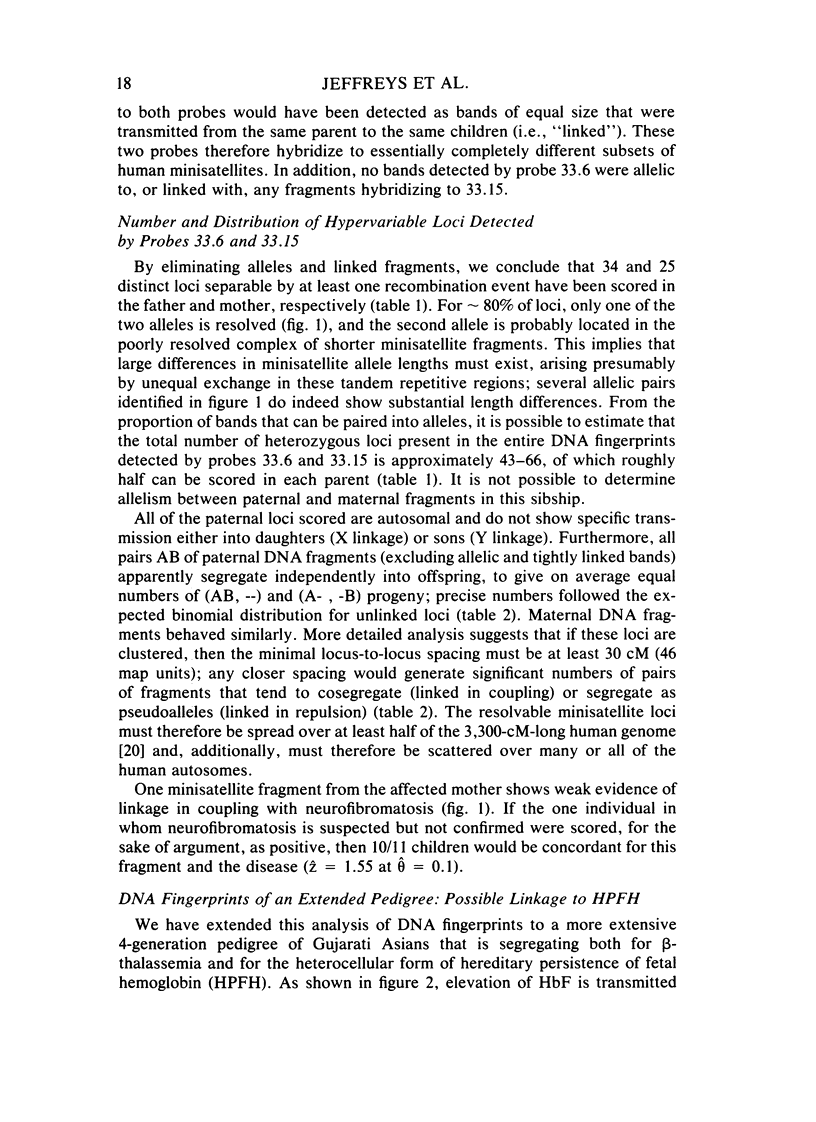
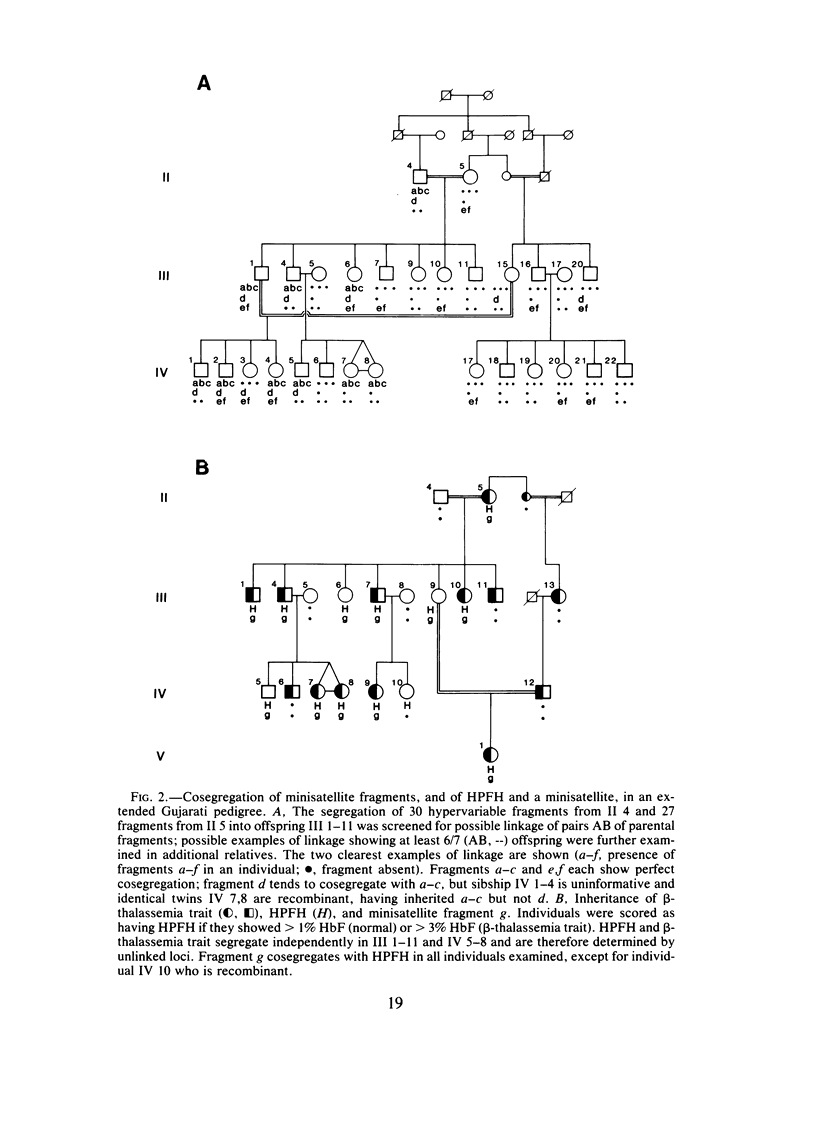
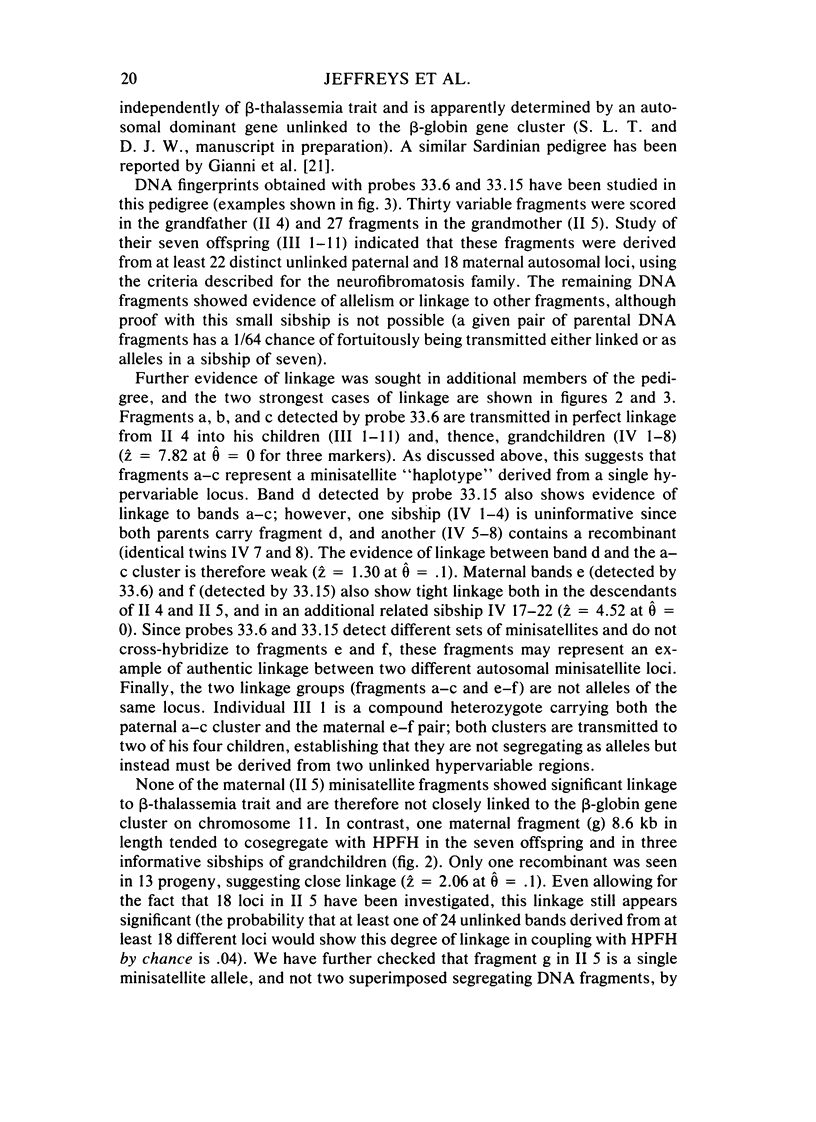
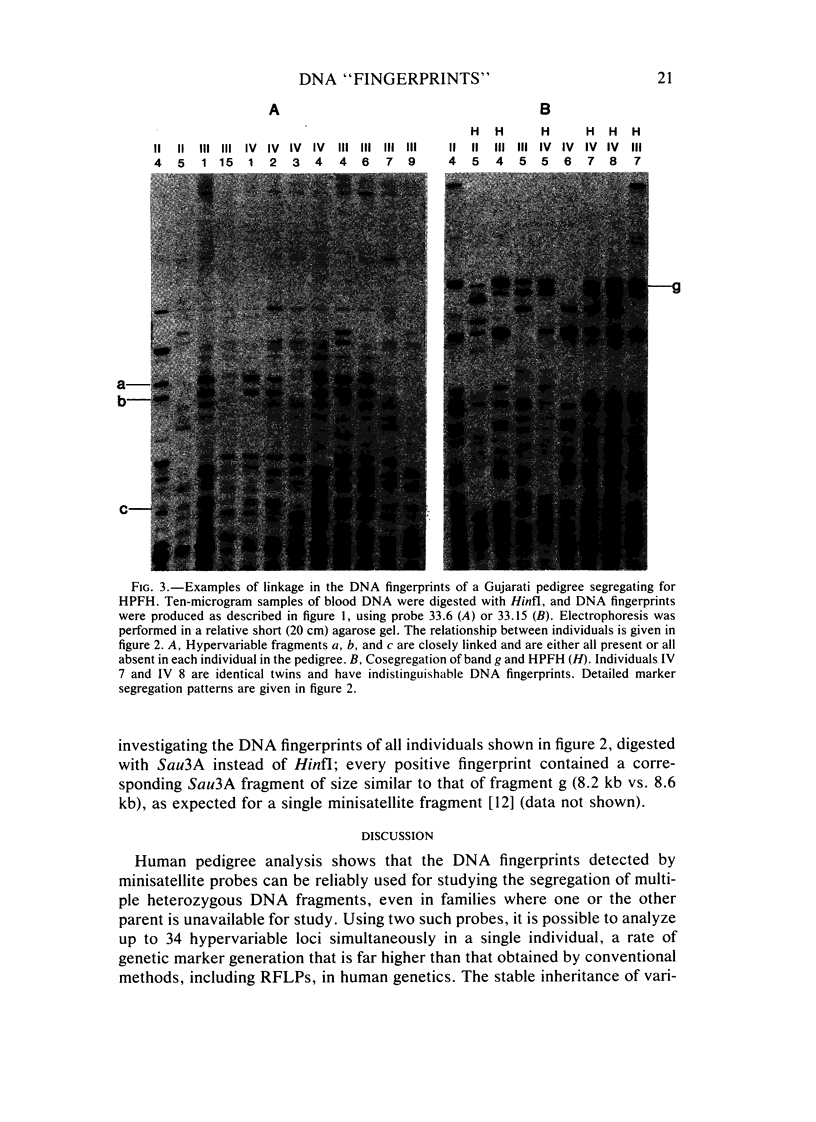
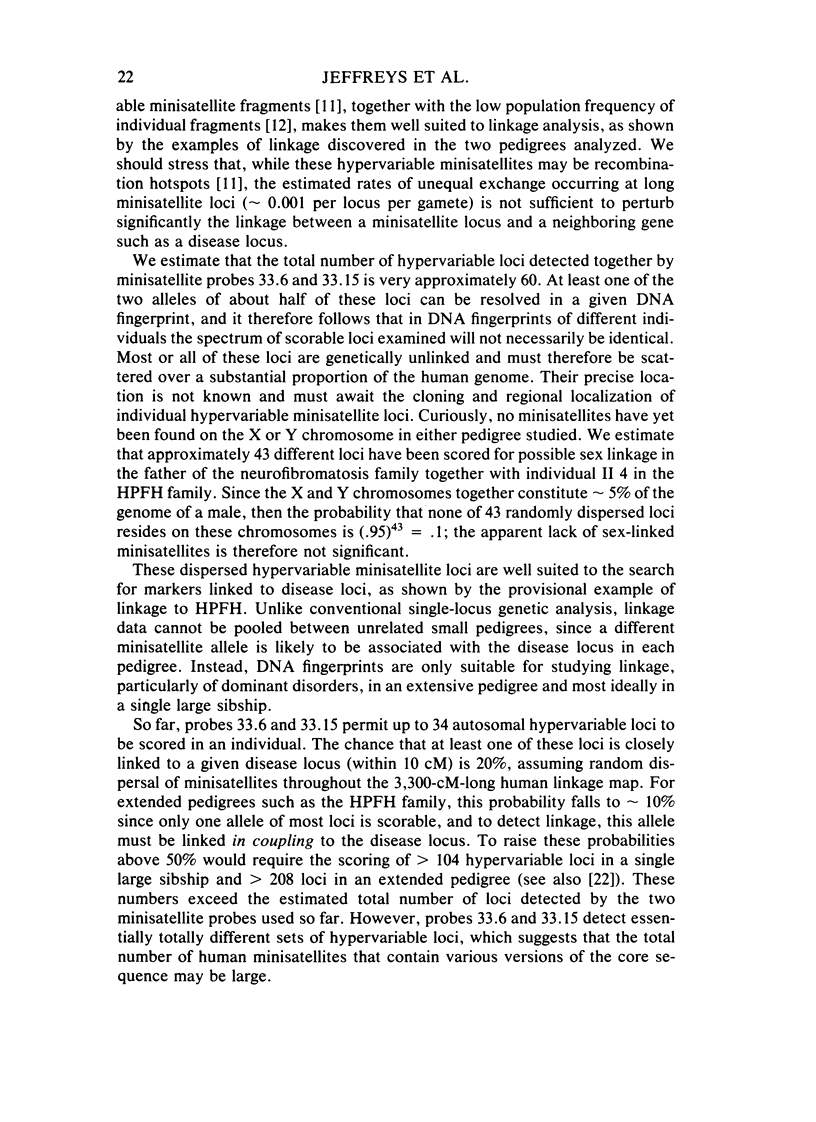
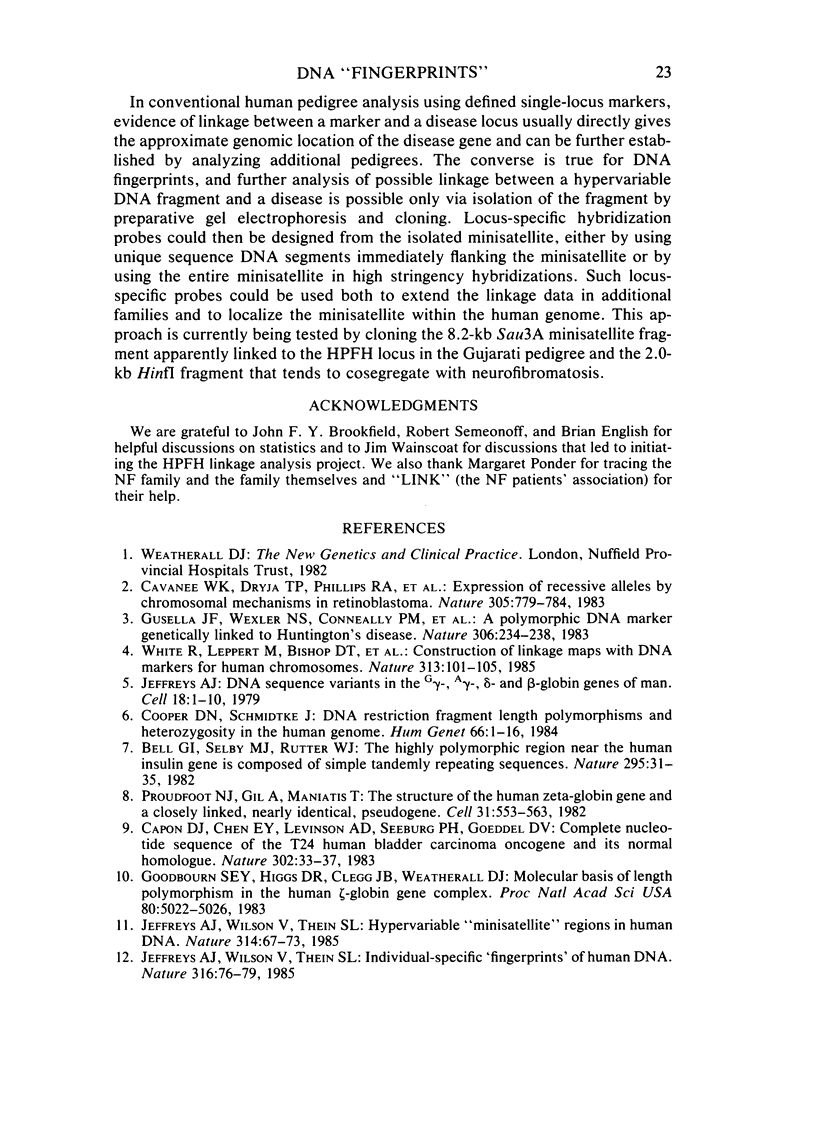
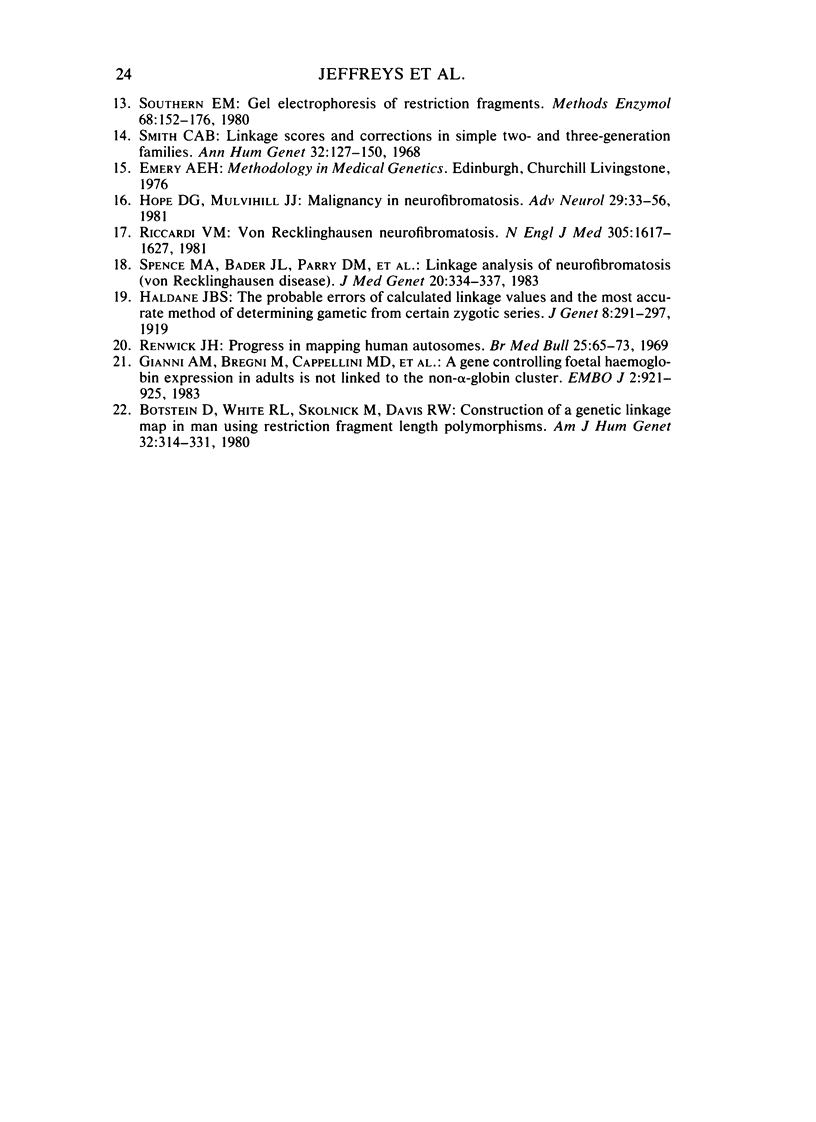
Images in this article
Selected References
These references are in PubMed. This may not be the complete list of references from this article.
- Bell G. I., Selby M. J., Rutter W. J. The highly polymorphic region near the human insulin gene is composed of simple tandemly repeating sequences. Nature. 1982 Jan 7;295(5844):31–35. doi: 10.1038/295031a0. [DOI] [PubMed] [Google Scholar]
- Botstein D., White R. L., Skolnick M., Davis R. W. Construction of a genetic linkage map in man using restriction fragment length polymorphisms. Am J Hum Genet. 1980 May;32(3):314–331. [PMC free article] [PubMed] [Google Scholar]
- Capon D. J., Chen E. Y., Levinson A. D., Seeburg P. H., Goeddel D. V. Complete nucleotide sequences of the T24 human bladder carcinoma oncogene and its normal homologue. Nature. 1983 Mar 3;302(5903):33–37. doi: 10.1038/302033a0. [DOI] [PubMed] [Google Scholar]
- Cavenee W. K., Dryja T. P., Phillips R. A., Benedict W. F., Godbout R., Gallie B. L., Murphree A. L., Strong L. C., White R. L. Expression of recessive alleles by chromosomal mechanisms in retinoblastoma. 1983 Oct 27-Nov 2Nature. 305(5937):779–784. doi: 10.1038/305779a0. [DOI] [PubMed] [Google Scholar]
- Cooper D. N., Schmidtke J. DNA restriction fragment length polymorphisms and heterozygosity in the human genome. Hum Genet. 1984;66(1):1–16. doi: 10.1007/BF00275182. [DOI] [PubMed] [Google Scholar]
- Gianni A. M., Bregni M., Cappellini M. D., Fiorelli G., Taramelli R., Giglioni B., Comi P., Ottolenghi S. A gene controlling fetal hemoglobin expression in adults is not linked to the non-alpha globin cluster. EMBO J. 1983;2(6):921–925. doi: 10.1002/j.1460-2075.1983.tb01522.x. [DOI] [PMC free article] [PubMed] [Google Scholar]
- Goodbourn S. E., Higgs D. R., Clegg J. B., Weatherall D. J. Molecular basis of length polymorphism in the human zeta-globin gene complex. Proc Natl Acad Sci U S A. 1983 Aug;80(16):5022–5026. doi: 10.1073/pnas.80.16.5022. [DOI] [PMC free article] [PubMed] [Google Scholar]
- Gusella J. F., Wexler N. S., Conneally P. M., Naylor S. L., Anderson M. A., Tanzi R. E., Watkins P. C., Ottina K., Wallace M. R., Sakaguchi A. Y. A polymorphic DNA marker genetically linked to Huntington's disease. Nature. 1983 Nov 17;306(5940):234–238. doi: 10.1038/306234a0. [DOI] [PubMed] [Google Scholar]
- Hope D. G., Mulvihill J. J. Malignancy in neurofibromatosis. Adv Neurol. 1981;29:33–56. [PubMed] [Google Scholar]
- Jeffreys A. J. DNA sequence variants in the G gamma-, A gamma-, delta- and beta-globin genes of man. Cell. 1979 Sep;18(1):1–10. doi: 10.1016/0092-8674(79)90348-9. [DOI] [PubMed] [Google Scholar]
- Jeffreys A. J., Wilson V., Thein S. L. Hypervariable 'minisatellite' regions in human DNA. Nature. 1985 Mar 7;314(6006):67–73. doi: 10.1038/314067a0. [DOI] [PubMed] [Google Scholar]
- Jeffreys A. J., Wilson V., Thein S. L. Individual-specific 'fingerprints' of human DNA. Nature. 1985 Jul 4;316(6023):76–79. doi: 10.1038/316076a0. [DOI] [PubMed] [Google Scholar]
- Proudfoot N. J., Gil A., Maniatis T. The structure of the human zeta-globin gene and a closely linked, nearly identical pseudogene. Cell. 1982 Dec;31(3 Pt 2):553–563. doi: 10.1016/0092-8674(82)90311-7. [DOI] [PubMed] [Google Scholar]
- Renwick J. H. Progress in mapping human autosomes. Br Med Bull. 1969 Jan;25(1):65–73. doi: 10.1093/oxfordjournals.bmb.a070673. [DOI] [PubMed] [Google Scholar]
- Riccardi V. M. Von Recklinghausen neurofibromatosis. N Engl J Med. 1981 Dec 31;305(27):1617–1627. doi: 10.1056/NEJM198112313052704. [DOI] [PubMed] [Google Scholar]
- Smith C. A. Linkage scores and corrections in simple two- and three-generation families. Ann Hum Genet. 1968 Oct;32(2):127–150. doi: 10.1111/j.1469-1809.1968.tb00058.x. [DOI] [PubMed] [Google Scholar]
- Southern E. Gel electrophoresis of restriction fragments. Methods Enzymol. 1979;68:152–176. doi: 10.1016/0076-6879(79)68011-4. [DOI] [PubMed] [Google Scholar]
- Spence M. A., Bader J. L., Parry D. M., Field L. L., Funderburk S. J., Rubenstein A. E., Gilman P. A., Sparkes R. S. Linkage analysis of neurofibromatosis (von Recklinghausen disease). J Med Genet. 1983 Oct;20(5):334–337. doi: 10.1136/jmg.20.5.334. [DOI] [PMC free article] [PubMed] [Google Scholar]
- White R., Leppert M., Bishop D. T., Barker D., Berkowitz J., Brown C., Callahan P., Holm T., Jerominski L. Construction of linkage maps with DNA markers for human chromosomes. Nature. 1985 Jan 10;313(5998):101–105. doi: 10.1038/313101a0. [DOI] [PubMed] [Google Scholar]




